红楼梦杨译本中双关语的翻译_
- 格式:pdf
- 大小:251.94 KB
- 文档页数:5
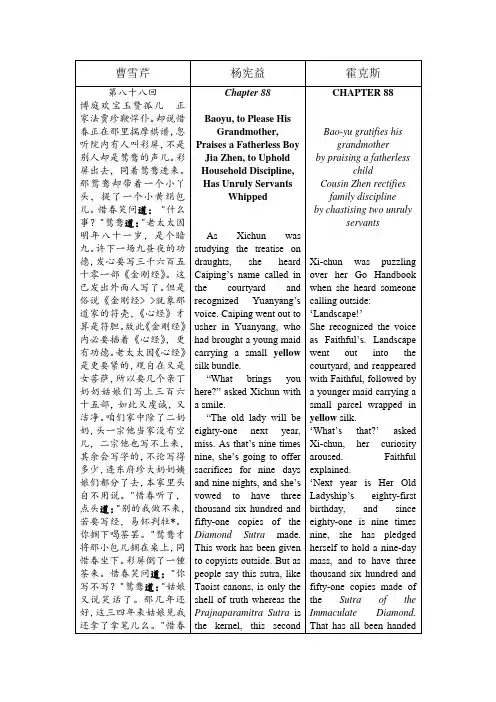
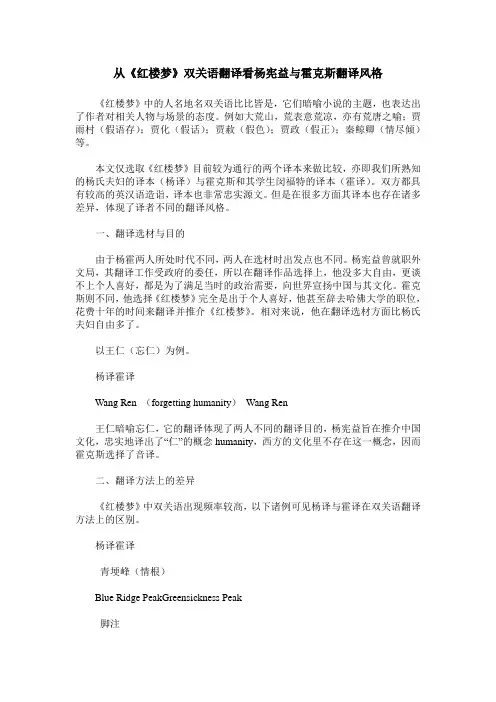
从《红楼梦》双关语翻译看杨宪益与霍克斯翻译风格《红楼梦》中的人名地名双关语比比皆是,它们暗喻小说的主题,也表达出了作者对相关人物与场景的态度。
例如大荒山,荒表意荒凉,亦有荒唐之喻;贾雨村(假语存);贾化(假话);贾赦(假色);贾政(假正);秦鲸卿(情尽倾)等。
本文仅选取《红楼梦》目前较为通行的两个译本来做比较,亦即我们所熟知的杨氏夫妇的译本(杨译)与霍克斯和其学生闵福特的译本(霍译)。
双方都具有较高的英汉语造诣,译本也非常忠实源文。
但是在很多方面其译本也存在诸多差异,体现了译者不同的翻译风格。
一、翻译选材与目的由于杨霍两人所处时代不同,两人在选材时出发点也不同。
杨宪益曾就职外文局,其翻译工作受政府的委任,所以在翻译作品选择上,他没多大自由,更谈不上个人喜好,都是为了满足当时的政治需要,向世界宣扬中国与其文化。
霍克斯则不同,他选择《红楼梦》完全是出于个人喜好,他甚至辞去哈佛大学的职位,花费十年的时间来翻译并推介《红楼梦》。
相对来说,他在翻译选材方面比杨氏夫妇自由多了。
以王仁(忘仁)为例。
杨译霍译Wang Ren (forgetting humanity)Wang Ren王仁暗喻忘仁,它的翻译体现了两人不同的翻译目的,杨宪益旨在推介中国文化,忠实地译出了“仁”的概念humanity,西方的文化里不存在这一概念,因而霍克斯选择了音译。
二、翻译方法上的差异《红楼梦》中双关语出现频率较高,以下诸例可见杨译与霍译在双关语翻译方法上的区别。
杨译霍译青埂峰(情根)Blue Ridge PeakGreensickness Peak脚注Homophone for “roots of love”仁清巷(人情)Lane of Humanity and Purity Carnal Lane娇杏(侥幸)Jiao XingLucky霍启(祸起)Huo QiCalamity卜世仁(不是人)Bu ShirenBu Shi-ren十里街(势利)Ten-li StreetWordly Way群芳髓(碎)Marrow of Manifold Fragrance Belle Se Fanent千红一窟(哭)Thousand Red flowers in one cavern Maiden’s Tears万艳同杯(悲)Ten Thousand Beauties in One Cup Lachrymae Rerun从上述诸例可以看出,杨宪益在翻译双关语时比较喜欢用脚注,通过脚注来解释那些难以翻译尽意的双关语,这样也避免了译文的行文拖沓。
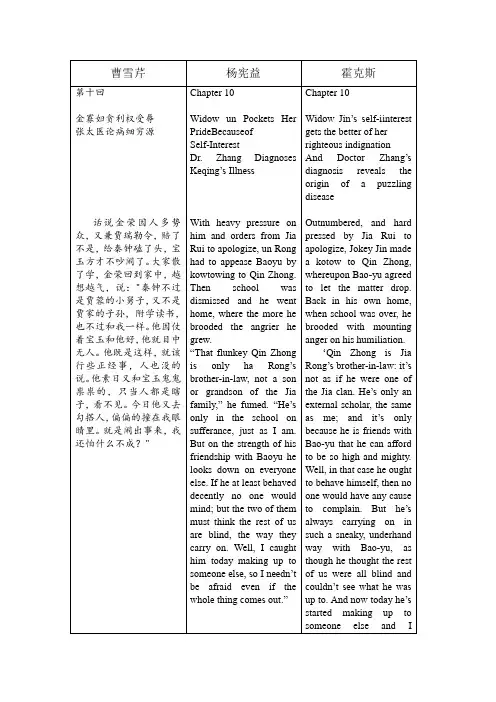
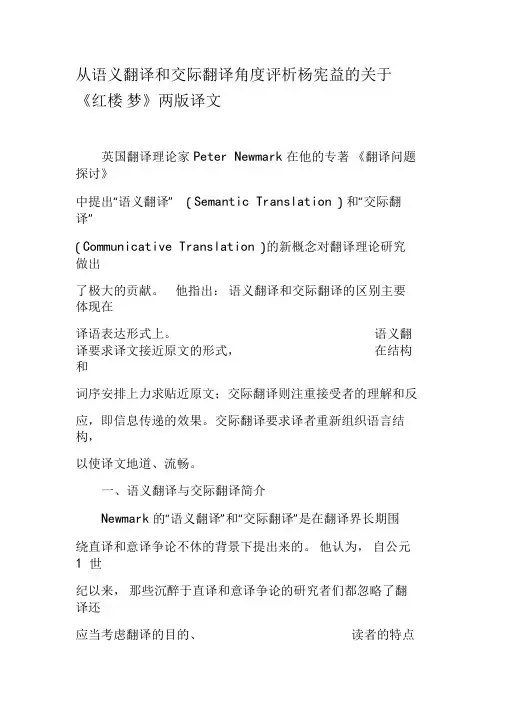
从语义翻译和交际翻译角度评析杨宪益的关于《红楼梦》两版译文英国翻译理论家Peter Newmark在他的专著《翻译问题探讨》中提出“语义翻译”( Semantic Translation ) 和“交际翻译”( Communicative Translation )的新概念对翻译理论研究做出了极大的贡献。
他指出:语义翻译和交际翻译的区别主要体现在译语表达形式上。
语义翻译要求译文接近原文的形式,在结构和词序安排上力求贴近原文;交际翻译则注重接受者的理解和反应,即信息传递的效果。
交际翻译要求译者重新组织语言结构,以使译文地道、流畅。
一、语义翻译与交际翻译简介Newmark的“语义翻译”和“交际翻译”是在翻译界长期围绕直译和意译争论不休的背景下提出来的。
他认为,自公元1 世纪以来,那些沉醉于直译和意译争论的研究者们都忽略了翻译还应当考虑翻译的目的、读者的特点和文本的类型,争论双方都把翻译过程看得太过理想化了。
忠实于原文还是忠实于译文的矛盾是翻译理论和实践中永恒的主题,但Newmark认为这种矛盾是可以调和的。
在语义翻译中,目标文本应该在目标语的语义和句法结构允许的情况下尽可能准确地再现原文的语境意义。
语义翻译拥有逐字翻译、直译和忠实翻译的优势,但它与直译的区别在于,直译后的译文只能将原文本词语的基本意义翻译出来,虽然符合目标语的句法结构,但未考虑原语用语的语境因素和使用场合。
在语义翻译中,译者首先必须忠于原作者,服从原语文化,只在对原语文本的内涵意义理解出现解障碍时才加以解释。
因此,语义翻译有时更倾向于超额翻译( overtranslation );相比较而言,交际翻译拥有归化、意译和地道翻译的优势。
在交际翻译中,目标文本所产生的效果应力求接近原文本。
由于重效果而不重内容,所以交际翻译首先要忠实于目标语和目标文本的读者,要求原语服从目标语的文化,不给读者留下晦涩难懂之处。
因此,交际翻译有时更倾向于欠额翻译( undertranslation )。
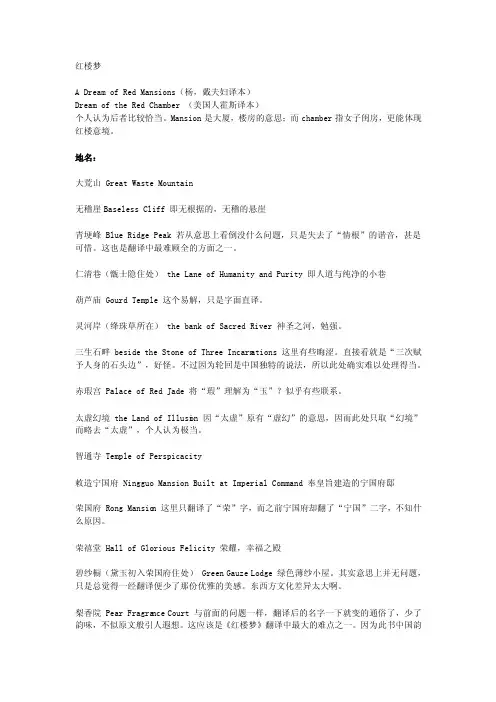
红楼梦A Dream of Red Mansion s(杨,戴夫妇译本)Dream of the Red Chamber(美国人霍斯译本)个人认为后者比较恰当。
Mansion是大厦,楼房的意思;而chambe r指女子闺房,更能体现红楼意境。
地名:大荒山 Great Waste Mountai n无稽崖Base less Cliff 即无根据的,无稽的悬崖青埂峰 Blue Ridge Peak 若从意思上看倒没什么问题,只是失去了“情根”的谐音,甚是可惜。
这也是翻译中最难顾全的方面之一。
仁清巷(甑士隐住处) the Lane of Humanit y and Purity即人道与纯净的小巷葫芦庙 Gourd Temple这个易解,只是字面直译。
灵河岸(绛珠草所在) the bank of SacredRiver 神圣之河,勉强。
三生石畔 besidethe Stone of Three Incarna tions这里有些晦涩。
直接看就是“三次赋予人身的石头边”,好怪。
不过因为轮回是中国独特的说法,所以此处确实难以处理得当。
赤瑕宫 Palaceof Red Jade 将“瑕”理解为“玉”?似乎有些联系。
太虚幻境 the Land of Illusio n 因“太虚”原有“虚幻”的意思,因而此处只取“幻境”而略去“太虚”,个人认为极当。
智通寺 Templeof Perspic acity敕造宁国府 Ningguo Mansion Built at Imperia l Command奉皇旨建造的宁国府邸荣国府 Rong Mansion这里只翻译了“荣”字,而之前宁国府却翻了“宁国”二字,不知什么原因。
荣禧堂 Hall of Gloriou s Felicit y 荣耀,幸福之殿碧纱橱(黛玉初入荣国府住处) Green Gauze Lodge 绿色薄纱小屋。
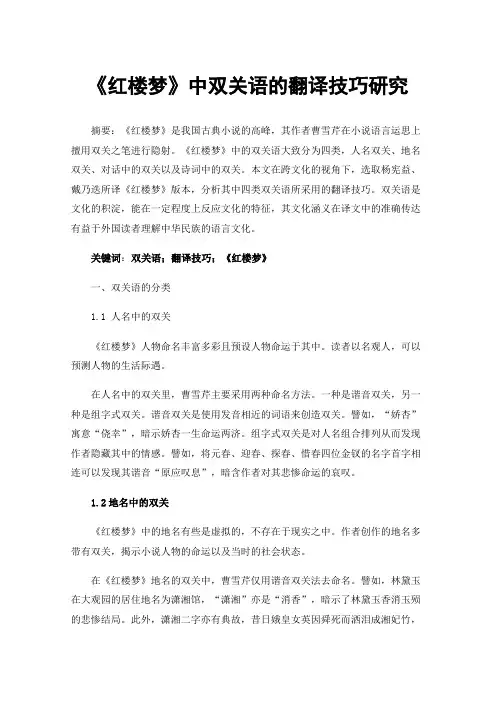
《红楼梦》中双关语的翻译技巧研究摘要:《红楼梦》是我国古典小说的高峰,其作者曹雪芹在小说语言运思上擅用双关之笔进行隐射。
《红楼梦》中的双关语大致分为四类,人名双关、地名双关、对话中的双关以及诗词中的双关。
本文在跨文化的视角下,选取杨宪益、戴乃迭所译《红楼梦》版本,分析其中四类双关语所采用的翻译技巧。
双关语是文化的积淀,能在一定程度上反应文化的特征,其文化涵义在译文中的准确传达有益于外国读者理解中华民族的语言文化。
关键词:双关语;翻译技巧;《红楼梦》一、双关语的分类1.1 人名中的双关《红楼梦》人物命名丰富多彩且预设人物命运于其中。
读者以名观人,可以预测人物的生活际遇。
在人名中的双关里,曹雪芹主要采用两种命名方法。
一种是谐音双关,另一种是组字式双关。
谐音双关是使用发音相近的词语来创造双关。
譬如,“娇杏”寓意“侥幸”,暗示娇杏一生命运两济。
组字式双关是对人名组合排列从而发现作者隐藏其中的情感。
譬如,将元春、迎春、探春、惜春四位金钗的名字首字相连可以发现其谐音“原应叹息”,暗含作者对其悲惨命运的哀叹。
1.2地名中的双关《红楼梦》中的地名有些是虚拟的,不存在于现实之中。
作者创作的地名多带有双关,揭示小说人物的命运以及当时的社会状态。
在《红楼梦》地名的双关中,曹雪芹仅用谐音双关法去命名。
譬如,林黛玉在大观园的居住地名为潇湘馆,“潇湘”亦是“消香”,暗示了林黛玉香消玉殒的悲惨结局。
此外,潇湘二字亦有典故,昔日娥皇女英因舜死而洒泪成湘妃竹,后又投水自尽,所以潇湘亦有情已成空,无可奈何之意,此地名也暗合黛玉泪尽而逝的结局。
1.3诗词中的双关《红楼梦》中的诗词并不只是用来装点的浮面累赘,其中也藏有双关,暗示人物命运的结局。
诗词如同谜底,隐射未来的天机,简短的尺幅之中笼罩着命盘推演的色彩。
在诗词中,曹雪芹共用了三种方式创造双关。
第一种是将人物姓名嵌入诗词中,李纨判词中的“桃李春风结子完”,“李完”谐音“李纨”,整句以大自然之现象预示李纨青春丧偶的命运。
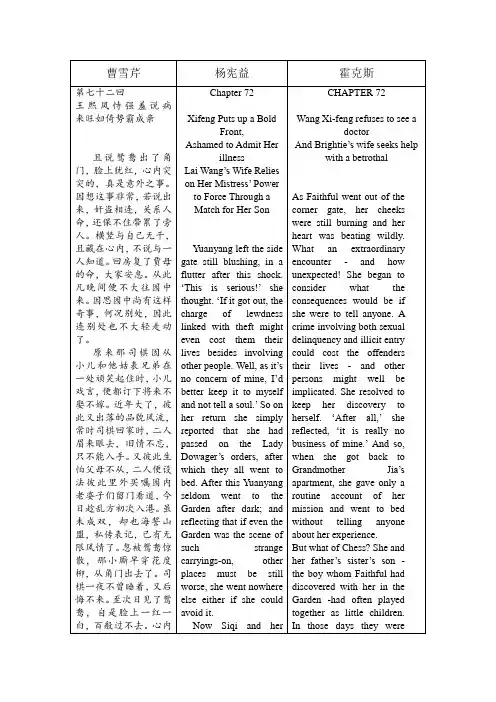
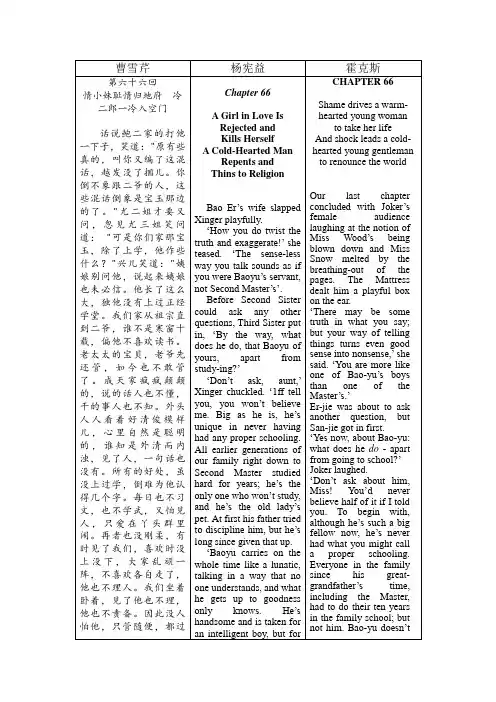
曹雪芹杨宪益霍克斯第六十六回情小妹耻情归地府冷二郎一冷入空门话说鲍二家的打他一下子,笑道:"原有些真的,叫你又编了这混话,越发没了捆儿。
你倒不象跟二爷的人,这些混话倒象是宝玉那边的了。
"尤二姐才要又问,忽见尤三姐笑问道: "可是你们家那宝玉,除了上学,他作些什么?"兴儿笑道:"姨娘别问他,说起来姨娘也未必信。
他长了这么大,独他没有上过正经学堂。
我们家从祖宗直到二爷,谁不是寒窗十载,偏他不喜欢读书。
老太太的宝贝,老爷先还管,如今也不敢管了。
成天家疯疯颠颠的,说的话人也不懂,干的事人也不知。
外头人人看着好清俊模样儿,心里自然是聪明的,谁知是外清而内浊,见了人,一句话也没有。
所有的好处,虽没上过学,倒难为他认得几个字。
每日也不习文,也不学武,又怕见人,只爱在丫头群里闹。
再者也没刚柔,有时见了我们,喜欢时没上没下,大家乱顽一阵,不喜欢各自走了,他也不理人。
我们坐着卧着,见了他也不理,他也不责备。
因此没人怕他,只管随便,都过Chapter 66A Girl in Love IsRejected andKills HerselfA Cold-Hearted ManRepents andThins to ReligionBao Er’s wife slappedXinger playfully.‘How you do twist thetruth and exaggerate!’ sheteased. ‘The senselessway you talk sounds as ifyou were Baoyu’s servant,not Second Master’s’.Before Second Sistercould ask any otherquestions, Third Sister putin, ‘By the way, whatdoes he do, that Baoyu ofyours, apart fromstudying?’‘Don’t ask, aunt,’Xinger chuckled. ‘1ff tellyou, you won’t believeme. Big as he is, he’sunique in never havinghad any proper schooling.All earlier generations ofour family right down toSecond Master studiedhard for years; he’s theonly one who won’t study,and he’s the old lady’spet. At first his father triedto discipline him, but he’slong since given that up.‘Baoyu c arries on thewhole time like a lunatic,talking in a way that noone understands, and whathe gets up to goodnessonly knows. He’shandsome and is taken foran intelligent boy, but forCHAPTER 66Shame drives a warm-hearted young womanto take her lifeAnd shock leads a cold-hearted young gentlemanto renounce the worldOur last chapterconcluded with Joker’sfemale audiencelaughing at the notion ofMiss Wood’s beingblown down and MissSnow melted by thebreathing-out of thepages. The Mattressdealt him a playful boxon the ear.‘There may be sometruth in what you say;but your way of tellingthings turns even goodsense into nonsense,’ shesaid. ‘You are more likeone of Bao-yu’s boysthan one of theMaster’s.’Er-jie was about to askanother question, butSan-jie got in first.‘Yes now, about Bao-yu:what does he do- apartfrom going to school?’Joker laughed.‘Don’t ask about him,Miss! You’d neverbelieve half of it if I toldyou. To begin with,although he’s such a bigfellow now, he’s neverhad what you might calla proper schooling.Everyone in the familysince his great-grandfather’s time,including the Master,had to do their ten yearsin the family school; butnot him. Bao-yu doesn’t的去。
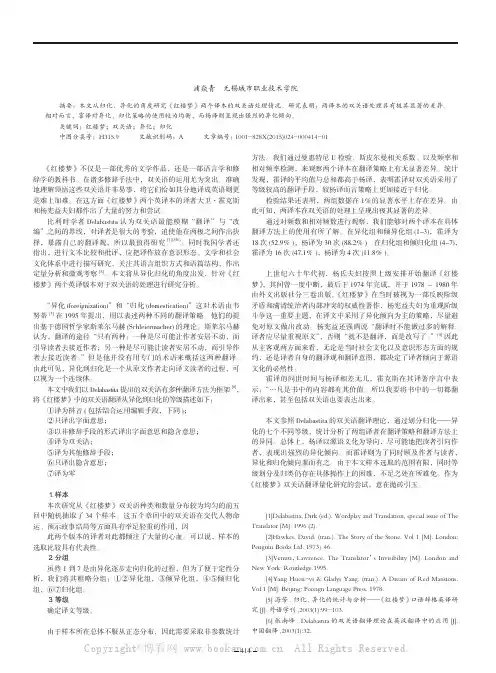
浦焱青 无锡城市职业技术学院摘要:本文从归化、异化的角度研究《红楼梦》两个译本的双关语处理情况。
研究表明:两译本的双关语处理具有极其显著的差异。
相对而言,霍译对异化、归化策略的使用较为均衡,而杨译则呈现出强烈的异化倾向。
关键词:红楼梦;双关语;异化;归化中图分类号:H315.9 文献识别码:A 文章编号:1001-828X(2015)024-000414-01一、引言《红楼梦》不仅是一部优秀的文学作品,还是一部语言学和修辞学的教科书。
在诸多修辞手法中,双关语的运用尤为突出。
准确地理解领悟这些双关语并非易事,将它们恰如其分地译成英语则更是难上加难。
在这方面《红楼梦》两个英译本的译者大卫·霍克斯和杨宪益夫妇都作出了大量的努力和尝试。
比利时学者Delabastita认为双关语最能模糊“翻译”与“改编”之间的界线,对译者是很大的考验,迫使他在两极之间作出抉择,暴露自己的翻译观,所以最值得研究[1](356)。
同时我国学者还指出,进行文本比较和批评,应把译作放在意识形态、文学和社会文化体系中进行描写研究,关注其语言组织方式和语篇结构,作出定量分析和微观考察[5]。
本文将从异化归化的角度出发,针对《红楼梦》两个英译版本对于双关语的处理进行研究分析。
二、研究框架“异化(foreignization)”和“归化(domestication)”这对术语由韦努蒂[3]在1995年提出,用以表述两种不同的翻译策略。
他们的提出基于德国哲学家斯莱尔马赫(Schleiermacher)的理论。
斯莱尔马赫认为,翻译的途径“只有两种:一种是尽可能让作者安居不动,而引导读者去接近作者;另一种是尽可能让读者安居不动,而引导作者去接近读者。
”但是他并没有用专门的术语来概括这两种翻译。
由此可见,异化到归化是一个从原文作者走向译文读者的过程,可以视为一个连续体。
本文中我们以Delabastita提出的双关语有多种翻译方法为框架[6],将《红楼梦》中的双关语翻译从异化到归化的等级描述如下:①译为拼音(包括结合运用编辑手段,下同);②只译出字面意思;③以非修辞手段的形式译出字面意思和隐含意思;④译为双关语;⑤译为其他修辞手段;⑥只译出隐含意思;⑦译为零。
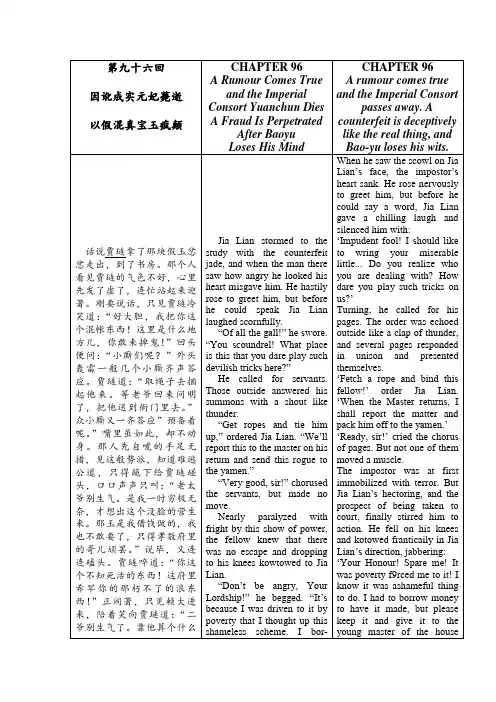
泪来。
贾政忙站起来说道:“老太太有话只管吩咐,儿子怎敢不遵命呢。
”贾母咽哽著说道:“我今年八十一岁的人了,你又要做外任去,偏有你大哥在家,你又不能告亲老。
你这一去了,我所疼的只有宝玉,偏偏的又病得糊涂,还不知道怎么样呢。
我昨日叫赖升媳妇出去叫人给宝玉算算命,这先生算得好灵,说要娶了金命的人帮扶他,必要冲冲喜才好,不然只怕保不住。
我知道你不信那些话,所以教你来商量。
你的媳妇也在这里。
你们两个也商量商量,还是要宝玉好呢,还是随他去呢?”贾政陪笑说道:“老太太当初疼儿子这么疼的,难道做儿子的就不疼自己的儿子不成么。
只为宝玉不上进,所以时常恨他,也不过是恨铁不成钢的意思。
老太太既要给他成家,这也是该当的,岂有逆着老太太不疼他的理。
如今宝玉病著,儿子也是不放心。
因老太太不叫他见我,所以儿子也不敢言语。
我到底瞧瞧宝玉是个什么病。
”王夫人见贾政说著也有些眼圈儿红,知道心里是疼的,便叫袭人扶了宝玉来。
宝玉见了他父亲,袭人叫他请安,他便请了个安。
贾政见他脸面很瘦,目光无神,大有疯傻之状,便叫人扶了进去,便想到:“自己也是望六的人了,如今又放外任,不知道几年回来。
倘或这孩子果然不好,一则年老无嗣,虽说有孙子,到底隔了一层,二则老太太最疼的是宝玉,若tearfully. “There is much Iwant to say to you, but willyou listen?”Jia Zheng promptly rose tohis feet.“Just give me your orders,madam. How dare your sondisobey them?”“I’m eighty-one this year,yet you’re going to post in theprovinces,” she sobbed. “Youcan’t ask for compassionateleave either, as you have anelder brother at home to takecare of me. Once you’re gone,there’ll b e only Baoyu herethat I care for, but the poorboy’s losing his mind and wedon’t know what will becomeof him! Yesterday I sent LaiSheng’s wife to get someoneto tell Baoyu’s fortune. Shefound a very clever fortune-teller who said, ‘He mustmarry a bride with gold in herstars to help counteract hisbad luck; otherwise there’llprobably be no saving him.’ Iknow you don’t believe insuch things, so I’ve asked youhere to consult you. Yourwife is here too, so the two ofyou can talk it over. Shouldwe try to save Baoyu? Or letthings take their course?”Jia Zheng answeredsubmissively, “You were sogood to your son, madam, doyou think I don’t love my sontoo? It’s only because Baoyumade so little progress that Iwas often exasperated withhim — just a case of wantingto ‘turn iron into steel.’ If youwish him to take a wife, as isright and proper, how could Idisobey you and show noconcern for him? I amworried too by his illness.Since you kept him away‘I shall be e ighty-one thisyear;’ said Grandmother Jia,sobbing as she spoke. ‘Youare going away to a post inthe provinces, and with yourelder brother still at home,you will not be able to applyfor early retirement to comeand look after me. When youare gone, of the ones closestto my heart I shall only haveBao-yu left to me. And he,poor darling, is in such awretched state, I don’t knowwhat we can do for him! Theother day I sent out LaiSheng’s wife to have theboy’s fortune told. The man’sreading was uncanny. Whathe said was: "This personmust marry a lady with adestiny of gold, to help himand support him. He must begiven a marriage as soon aspossible to turn his luck. Ifnot, he may not live.” Now Iknow you don’t believe insuch things, which is why Isent for you, to talk it overwith you. You and his mothermust discuss it amongyourselves. Are we to savehim, or are we to do nothingand watch him fade away?’Jia Zheng smiled anxiously.‘Could I, who as a childreceived such tender love andcare from you, Mother, nothave fatherly feelings myself?It is just that I have beenexasperated by his repeatedfailure to make progress in hisstudies, and have perhapsbeen too ambitious for him.You are perfectly right inwanting to see him married.How could I possibly wish tooppose you? I am concernedfor the boy, and his recentillness has caused me great有差错,可不是我的罪名更重了。

《红楼梦》杨宪益和霍克斯翻译对照–32引言《红楼梦》是中国古代四大名著之一,被誉为中国小说的巅峰之作。
随着世界的日益全球化,这部文学经典也开始被翻译成其他语言,让更多人了解中国文化。
在文学翻译领域,杨宪益和霍克斯两位翻译家都作出了杰出的贡献。
本文主要比较和探讨他们在翻译《红楼梦》中的差异和特点。
杨宪益翻译的特点杨宪益是中国著名的翻译家,擅长翻译文学作品。
他的《红楼梦》翻译堪称经典,深受读者喜爱。
杨宪益在翻译时注重保留原作的风格和韵味,力求忠实地传达原作的意境。
他的翻译语言通顺流畅,让人读起来感觉自然而不生硬。
同时,他也注重表达作者的思想和情感,对于其中的隐喻和象征意义作出了细致的解读。
在《红楼梦》的翻译中,杨宪益对居庙堂之高处和忘形于著书之中这句话的翻译是:“在朝廷宫殿高处,我忙忙碌碌;在研幽玩致性的著述中,我忘形于其中。
”这种翻译保留了原作中的意境和表达方式,体现了杨宪益的翻译风格。
霍克斯翻译的特点霍克斯是英国著名的翻译家,擅长翻译中国文学作品。
他翻译的《红楼梦》也备受赞誉。
霍克斯注重翻译的准确性和精准性,致力于将原作的细节和意义准确地传达给读者。
他的翻译语言简洁明了,条理清晰,让人容易理解。
在《红楼梦》的翻译中,霍克斯将居庙堂之高处和忘形于著书之中这句话翻译为:“When I am in high places at the Palace and busy myself with official duties, I forget myself; when I relax and forget myself in my literary pursuits, I seem to be at court.”这种翻译方式准确地传达了原作中的意思,让人对故事有更深的理解。
杨宪益和霍克斯翻译的差异和比较杨宪益和霍克斯在翻译《红楼梦》时有一些差异和特点。
首先,杨宪益注重表达原作的意境和情感,追求忠实地传达原作的思想。
浅析《红楼梦》中的谐音双关及其维吾尔语翻译作者:赛文娟来源:《文教资料》2014年第17期摘要:谐音双关是《红楼梦》中运用较为广泛的修辞格,它通过一个词或一句话表达两层或多层含义,具有暗示、揭露和嘲讽、幽默、含蓄和避讳、抱怨等多种功能。
由于文化和语言习惯的不同,谐音双关语所包含的内容很难通过翻译精准、完美地表现出来。
本文通过对《红楼梦》原著和维译本的对比,分析其中的谐音双关及其维吾尔语翻译。
关键词:《红楼梦》谐音双关维吾尔语翻译谐音双关是借助词语在发音上的相同或相似构成双重或多重意义,使一个语音能够关涉眼前和心理的两种或几种事物,让人们产生由表及里的联想。
《红楼梦》中的谐音双关有的预示人物命运,有的表达作者的褒贬感情,有的暗含对社会现实的讽刺和揭露,有的表现对悲剧人物的哀悼和惋惜。
根据《红楼梦》中谐音双关语的特点,将其分为以下几种:一、同音同形双关汉语中有些字、词具有多重含义,放在不同的句子或者不同的语境当中,所表达的意义不同,《红楼梦》作者利用汉语的这一特点,创作出了巧妙的双关。
(1)势败休云贵,家亡莫论亲。
偶因济刘氏,巧得遇恩人。
(第五回)这是“金陵十二钗”正册巧姐儿的判词。
“巧”表面是“恰巧”的意思,实际是王熙凤的女儿“巧姐”的“巧”。
这里利用谐音双关,暗示了巧姐的结局。
维译本中没有单独将“巧”字译出,而是译出了整句话,“?藓mdi k?覬rdy?耷 himmitini ba?蘩qa kyn ?誦y?蘩k?藓nd?藓 s?藓n”(在你落败的时候你就能看见这些恩德),维语中没有和这里的“巧”直接对应的双关词,所以,译者如此翻译也是合情合理的。
(2)焚花散麝,而闺阁始人含其劝矣。
(第二十一回)这是宝玉跟袭人怄气时写的句子,“花”既是“ɡyl”,在这里又双关为“袭人(?蘩iren)”,“麝”既是一种香“ipar”,又指“麝月(?蘩ej?覬)”。
宝玉赌气道:“那一个配比这些花,没的玷辱了好名好姓。
《红楼梦》两个英译本中双关语的翻译研究双关语的修饰手法,是很多国家的文化和语言的一个缩影。
双关语的翻译一直是翻译领域的一个难点。
《红楼梦》是中国古代文化和语言的优秀代表作品,书中双关语的使用丰富多彩,其双关语的翻译文本对相关领域的研究有较高的借鉴价值。
本文选取《红楼梦》两个英译本为例研究双关语的翻译,一个译本是A Dream of Red Mansions,由杨宪益、戴乃迭夫妇翻译:另一个译本是The Story of the Stone,由英国汉学家戴卫·霍克斯(David Hawkes)和约翰·闵福德(John Minford)合译。
本文以双关语研究学者德克·德拉巴斯蒂塔提出来的双关语翻译理论和翻译策略为指导,对比研究和分析了《红楼梦》两个英译本中有关双关语翻译的实例。
在对两个译本的双关语翻译策略进行描述性研究的基础上,结合了奈达先生的功能对等理论,分析和总结了不同译本的翻译方法与翻译思想以及它们产生的不同翻译效果,并评价了不同译文翻译策略的实用价值和意义。
本文共有五个章节组成。
第一章节是引言部分,介绍了论文的研究背景、研究目标以及写作方法。
第二章阐述了双关语的概念、分类以及双关语翻译的策略等问题。
第三章是文献综述部分,概述了德拉巴斯蒂塔的双关语翻译理论和奈达的功能对等理论,分析和研究了《红楼梦》中双关语的翻译现状,对前期的研究进行了总结。
第四章是论文的主体部分,按照双关语在《红楼梦》中不同的使用语境,结合了德拉巴斯蒂塔的双关语翻译理论和奈达的功能对等理论对两个版本的翻译文本进行了对比分析,归纳总结了不同文本的翻译思想和策略。
最后一章是本文的结论,指出两个译本在双关语翻译策略上各有千秋,都很好地体现了德拉巴斯蒂塔的双关语翻译理论,并在双关语翻译方法上有各自的特色。
从功能对等理论上来讲,两个译本通过各自的翻译策略实现了双关语的转换,为后人提供了很好的范本。
本文旨在寻求两个译本中双关语翻译策略的有效结合作为指导原则,以便能够更好地服务于相关领域的翻译工作,并在传播中国优秀文化的过程中更有效地发挥作用。
3.3 Barriers in Translation of PunsAs a kind of language phenomenon, pun is deep-rooted in language and culture. Since different languages bear different styles and expressive means, the Chinese pun, under the influences of its language and culture, bears the distinct traits which are different from those of the English pun. Puns can be easily translated if they come from the same language family that has near-equivalents in the source and target languages, particularly if they simply contrast the material and the figurative sense of the word. However, as we know, English and Chinese belong to different language families. The two languages are lexically different in writing and pronunciation, some words in one language even having no semantic equivalents in the other. Therefore, pun translation between Chinese and English really needs pains-taking efforts, if not completely impossible. Barriers in pun translation are mainly caused by differences in language and culture.3.3.1 Language BarriersLanguage barriers mostly occur in the translation of homophonic puns, whose appeal lie in the similarity of sound and disparity in meaning. Meng Jiangang points out that most English words are composed of two or more syllables. There are few words that share the same pronunciation. English puns are mainly based on the polysemy. On the other hand, a large number of Chinese words are monosyllable or disyllable. There are far less combinations of syllables in Chinese than in English because few Chinese words begin with vowels or have any consonant clusters. As a result, most Chinese puns fall into the homophonic category (Meng Jiangang, 2000: 3). To retain such puns depends on the coincident correspondence in pronunciation and word meaning between two languages. However, since Chinese belongs to Sino-Tibetan language family while English belongs to Indo-European language family, when a Chinese word is translated into its correspondent meaning in English, the coincidence in pronunciation will most probably disappear. Thus, translators have to struggle between the maintaining of sound and meaning, which are of equal importance in the pun translation. Liu Miqing maintains that the sound-form rhetoriccan seldom be perfectly transferred in the Chinese-English translation because the information channel of the bilingual transfer is blocked on the phonetic level. In other words, there is no meaningful correspondence on the phonetic level. Correspondence between different languages only exists on the semantic level (Liu Miqing, 1999:110). This explains why in most cases, the pun translation does not result in another pun in the target text.Moreover Chinese characters are the most distinguishing feature of Chinese. Most meaningful words in Chinese are composed of more than two Chinese characters. Therefore, an independent Chinese character, when combined with other characters, may lead to a new meaning. This unique feature supplies new means for writers to create puns. For example, the author of HLM sometimes embeds the punny words in a sentence or creates puns in a palindrome style. The following examples help to illustrate the idea:Example 10:桃李春风结子完(Cao Xueqin, Gao E, 1978: 75)Peach and plum in spring winds finish seeding. (Yang Xianyi, GladysYang,1978: 76)“李” in the original text means plum and “完” means “finish”. However when these two characters are put together it bears the same pronunciation as the name of a character “李纨”in the novel. The author creates the pun as a kind of riddle to imply the character’s fate.Example 11:玉带林中挂,金簪雪里埋。
(Cao Xueqin, Gao E, 1978: 73)Buried in snow the broken golden hairpinAnd hanging in the wood the belt of jade. (Yang Xianyi, GladysYang,1978: 74)“玉带林”means “the belt of jade” and “wood” respectively, but when these three characters are read in a reverted manner, their pronunciation coincides with that of the heroin’s name “林黛玉”.3.3.2 Culture BarriersTranslation activity involves two or more languages, which are sign systems consisting of social and cultural information. Culture plays an important part in the correct comprehension of the source text, which is essential for the production of a successful translation. Meng Jiangang holds that when doing translation, the translator deals with not only words and sentences but also the cultural backgrounds in which all the linguistic features are deeply rooted (Meng Jiangang, 2000:3). There exists an inter-related and interdependent relation between language and culture. Meng believes that a language can never be separated from its social environment just as a plant cannot live without its natural environment (Meng Jiangang, 2000:3). Culture affects people’s way of thinking and behaving in the world, which in turn is reflected in their use of language. Therefore ignorance of certain cultural backgrounds will most probably leads to misinterpretation of the original text.The definition of culture always seems to be elusive and complicated. Wang Yajuan summarized a definition of culture based on the Canadian anthropologist Bates’ and Plog’s theory as follows:Culture is a system of shared beliefs, values, customs, behaviors and artifacts that members of a society use to cope with their world and with one another, and that are transmitted from generation to generation through learning. This includes not only patterns of behavior but also patterns of thought (shared meanings that the members of a society attach to various phenomena, natural and intellectual, including religion and ideologies), artifacts (tools, pottery, houses, machines, works of art), and the culturally transmitted skills and techniques used to make the artifacts (Wang Yajuan,2004:21).In brief, culture may be defined as a system of shared knowledge, which exemplifies itself in history, art, customs and traditions. It sows the seed in people’s thoughts that finally becomes values and beliefs. Culture is in its essence a natural result of communication, acquisition, accumulation and interaction carried out by human being through the process of creating and using different signs. Culture diffuses in every aspect of people’s life. Translation barriers, no matter language onesor culture ones, can all be attributed to the differences in the sign behavior of different cultures.As mentioned above, Halliday believes that translation can be regarded as a process of discovering the meaning potential, which to a great extent is determined by the context. Such a trait of language can be best exemplified in the pun translation, whose value lies in the thorough comprehension of the meaning potential hidden in the context. The use of a pun is not only a linguistic phenomenon, but also a cultural one. The context in discussion includes not only the one in linguistic sense but also the cultural background which serves as a broader and more embracing context. All kinds of social context consist of a large culture context. Meng Jiangang maintains that context is rooted in culture habits, which in turn restricts context (Meng Jiangang, 2000:4). Cultural nuances make the pun translation more complex, as it is not so easy for a translator to understand and appreciate the point of a pun, let alone to reproduce it, even when he is familiar with the meanings and cultural background of the word or phrase used. Therefore translators should spare no effort to search for the unique meaning contained in the social and cultural context.Chapter Four The Socio-semiotic Approach to the Translation ofPuns4.1 Socio-semiotic Nature of PunsIn most cases, meaning is regarded as the priority in the translation process. However, when the translation of literary works is concerned, the reproduction of the style and aesthetic effect of the source text is of equal importance with the semantic faithfulness. The application of puns in literary works highlights the beauty of language and creates a thought-provoking effect. The appeal of puns lies in the polygamic relationship between sound and meaning of words. Sound and meaning are of equal value in the comprehension of puns. Therefore translating meanings alone is not enough to reproduce a whole picture of the function and the aesthetic attraction puns possess in the source text. Sound also contends meaning in puns, which serves as a bridge to combine the double context as an organic whole in a word. The writer counts on the sound of puns to guide readers and help them find the associative meaning which conveys the writer’s real intention. By using puns, the writer intentionally conceals the intended meanings in the context instead of presenting them to readers directly, which creates an aesthetic distance between readers and the text.As mentioned above, translators are bound to meet with both language and culture barriers in the pun translation. Many translators choose to interpret the hidden meaning and give up the rhetoric effect contained in the sound and form of puns. Thus the aesthetic distance skillfully crafted by the writer of the source text is rendered void. The intended meaning is just like an uncut jade while the rhetoric means of punning represents the supreme skills of the lapidary, without which the stone will never become a valuable artifact. Socio-semiotic approach emphasizes the fact that all kinds of signs carry meanings, so do sound and form of a pun. Thus, translating Chinese puns consists in reproducing in the English language the closest natural equivalent of。